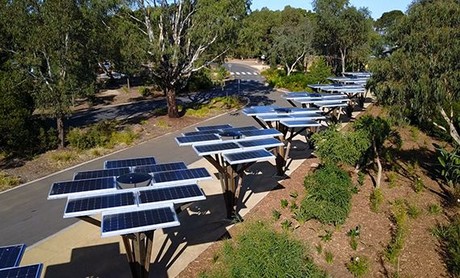CEC Solar Design and Installation Awards — finalists announced

A standalone solar PV system inspired by the African thorn tree, a rooftop solar installation and a 68-year-old diesel train converted into the world’s first solar-powered train in Byron Bay, NSW, are among the finalists in the 2018 Clean Energy Council Solar Design and Installation Awards.
“This year is shaping up to be another record one for the Australian solar industry, with over 700 MW of solar installed in the first six months of 2018. This is almost 50% higher than the year before, when the most solar power in history was installed across our nation’s rooftops,” said Clean Energy Council Chief Executive Kane Thornton.
Award finalists have been named across the following categories: under 30 kW standalone PV power system, under 30 kW grid connect PV power system and grid connect with battery back-up, 30–240 kW and over 240 kW.
The finalists were selected by an independent panel of solar industry experts. To find out more about this year’s finalists and view pictures of their work, as well as those from previous years, visit the CEC website. The winners of the 2018 Solar Design and Installation Awards will be announced on Wednesday, 3 October at the All-Energy Australia Exhibition and Conference in Melbourne.
All-Energy Australia is being held in partnership with the Clean Energy Council and Reed Exhibitions. It will run from 3-4 October at the Melbourne Convention and Exhibition Centre. Entrance to the exhibition is free, as is entry to the awards presentation ceremony which is held as part of the Grand Networking Event at the end of the first day of the conference.
Below is the full list of finalists:
Under 30 kW — standalone PV power system
- Bruce McRae and Soleman Massoud (Autonomous Energy) for a standalone solar PV system inspired by the African thorn tree at the Werribee Open Range Zoo in Melbourne.
- Michael Reiken (Excel Power) for a steampunk-inspired solar PV system to allow a workshop and office to run completely off-grid with two days’ autonomy.
- Simon Duff (Towards Tomorrow Energy) for a solar PV system that enabled an award-winning flat packed, redeployable small building to be situated without the need to be connected to mains power.
Under 30 kW — grid connect PV power system and grid connect with battery back-up
- Florian Geier (SolarHub) for an 8.91 kW solar PV system and battery that was connected to Reposit Power’s Capital Region Distributed Virtual Power Plant in Canberra.
- Luke Fraser (Solar Integrity) for a combined solar PV and battery system that demonstrates how residences connected to single wire earth return lines can install larger solar systems.
- Matthew Leeson (Leeson Solar) for a 6.75 kW building-integrated PV solar tile system on the Austral Bricks display centre in Rochedale, Queensland.
- Stephen Mason and Roberta Colombo (Evergen) for three solar PV systems with batteries on a 10-storey apartment building in Brisbane.
30–240 kW — any system eligible
- Geoff Fussell and Guy Cameron (Suntrix) for designing and installing Australia’s first modular and scalable floating solar PV system in Lismore, NSW.
- Jamie Thorncraft, Edie Barkla-Mather and Juan Jose Ferrandis Giral (Todae Solar) for a 66 kW solar PV system on a 45-degree pyramid in the Sydney CBD.
- Nicholas Lake, Gregory Wilson and Simon Gibbs (Nickel Energy) for converting a 68-year-old diesel train to become the world’s first solar-powered train in Byron Bay, NSW.
Over 240 kW — any system eligible
- Jarrod Shepherd and Matthew Linney (Autonomous Energy) for a 2.2 MW rooftop solar system on the Sydney Markets, said to be the largest privately owned rooftop solar installation in the Southern Hemisphere.
- Robert Mailler (YD Projects) for the 11 MW Dunblane Solar Farm in Barcaldine, Queensland.
- Scott Mason, Murtaza Lukemanjee and Callum Beaton (Platinum Solar Designs) for a 500 kW ground mount solar PV system with a 2.1 MWh battery at the Willinga Park Equestrian Centre in NSW.
Fujitsu General Australia announces name change
Following its acquisition by Paloma Rheem Holdings, the company is now operating as General...
Qld Govt announces electrotechnology training centre
The Electrotechnology Centre at TAFE Queensland's Alexandra Hills Campus is being set up to...
Calling all HVAC&R professionals
Registration has opened for ARBS 2026, a major Australian exhibition for the air conditioning,...



